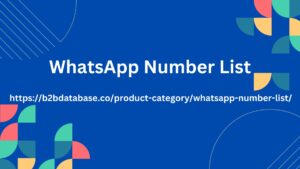With its wide user base and real-time communication capabilities, WhatsApp has become a powerful tool for businesses and individuals alike.
To maximize its effectiveness, it is essential to understand the types of messages that resonate best with your audience.
1. Personalized messages
Tailored content: Address the
Algeria WhatsApp Number List Database recipient by name and provide specific details about their interests or previous interactions.
Example: "Hi [Name], I noticed you've been browsing our [Products] collection recently. We have a new [Feature] you might be interested in."
2. Current news
Relevance: Send messages when they are most likely to be relevant and appreciated.
Example: "Reminder: Your [Order] will be delivered tomorrow. Please make sure someone is available to receive it."
3. Clear and concise messages
Directness: Avoid overly long or complex messages that may be difficult to understand.
Example: “We are excited to announce [Sale] from [Date]. Enjoy [discount] on all orders.”
4. Call-to-Action (CTA) messages.
Drive engagement: Use strong calls to action to get recipients to take desired actions.
Example: "Click here to go to [link] and get [offer]."
5. Multimedia messages
Visual appeal: Enhance your messages with images, videos or GIFs to grab attention.
Example: “Check out our latest [product] on sale! [Video]"

6. Interactive messages
Engagement: Encourage two-way communication through polls, quizzes, or quick response options.
Example: "What's your favorite [product] flavor? Vote below!"
7. Conversational tone
Natural language: Use language that is natural and approachable, as if you were talking to a friend.
Example: "Hello, how is your day?"
8. Limited frequency
Avoid overloading: Respect your recipients' time and avoid bombarding them with messages.
Example: Stick to a reasonable frequency, like once or twice a day.
9. Options for logging in and logging out
Respect privacy: Give users clear options to opt-in or opt-out of your messages.
Example: "Want to stay in the loop? Answer 'YES' and join our mailing list."
10. A/B testing
Experiment: Try different message variations to see what works best for your audience.
Example: Try different calls to action or subject line to see which ones increase engagement.
By following these guidelines and understanding your audience's preferences, you can create effective WhatsApp messages that build relationships, drive conversions, and improve your overall communication strategy.